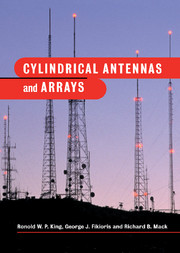Book contents
- Frontmatter
- Contents
- Preface
- Preface to first edition
- 1 Introduction
- 2 An approximate analysis of the cylindrical antenna
- 3 The two-element array
- 4 The circular array
- 5 The circuit and radiating properties of curtain arrays
- 6 Arrays with unequal elements: parasitic and log-periodic antennas
- 7 Planar and three-dimensional arrays
- 8 Vertical dipoles on and over the earth or sea
- 9 Dipoles parallel to the plane boundaries of layered regions; horizontal dipole over, on, and in the earth or sea
- 10 Application of the two-term theory to general arrays of parallel non-staggered elements
- 11 Resonances in large circular arrays of perfectly conducting dipoles
- 12 Resonances in large circular arrays of highly conducting dipoles
- 13 Direct numerical methods: a detailed discussion
- 14 Techniques and theory of measurements
- Appendix I Tables of Ψd R, T(m) or T′(m) and self-and mutual admittances for single elements and circular arrays
- Appendix II Tables of matrix elements Φu and Φυ for curtain arrays
- Appendix III Tables of admittance and impedance for curtain arrays
- References
- List of symbols
- Index
3 - The two-element array
Published online by Cambridge University Press: 07 August 2009
- Frontmatter
- Contents
- Preface
- Preface to first edition
- 1 Introduction
- 2 An approximate analysis of the cylindrical antenna
- 3 The two-element array
- 4 The circular array
- 5 The circuit and radiating properties of curtain arrays
- 6 Arrays with unequal elements: parasitic and log-periodic antennas
- 7 Planar and three-dimensional arrays
- 8 Vertical dipoles on and over the earth or sea
- 9 Dipoles parallel to the plane boundaries of layered regions; horizontal dipole over, on, and in the earth or sea
- 10 Application of the two-term theory to general arrays of parallel non-staggered elements
- 11 Resonances in large circular arrays of perfectly conducting dipoles
- 12 Resonances in large circular arrays of highly conducting dipoles
- 13 Direct numerical methods: a detailed discussion
- 14 Techniques and theory of measurements
- Appendix I Tables of Ψd R, T(m) or T′(m) and self-and mutual admittances for single elements and circular arrays
- Appendix II Tables of matrix elements Φu and Φυ for curtain arrays
- Appendix III Tables of admittance and impedance for curtain arrays
- References
- List of symbols
- Index
Summary
The method of symmetrical components
An array is a configuration of two or more antennas so arranged that the superposition of the electromagnetic fields maintained at distant points by the currents in the individual elements yields a resultant field that fulfils certain desirable directional properties. Since the individual elements in an array are quite close together – the distance between adjacent elements is often a half-wavelength or less – the currents in them necessarily interact. It follows that the distributions of both the amplitude and the phase of the current along each element depend not only on the length, radius, and driving voltage of that element, but also on the distributions in amplitude and phase of the currents along all elements in the array. Since these currents are the primary unknowns from which the radiation field and the driving-point admittance are computed, it is essential that they be determined accurately and not arbitrarily assumed to have identical distributions, as in uniform array theory.
In order to introduce the properties of arrays in a simple and direct manner, it is advantageous to study first the two-element array in some detail. The integral equation (2.15) for the current in a single isolated antenna is readily generalized to apply to the two identical parallel and non-staggered elements shown in Fig. 3.1. It is merely necessary to add to the vector potential on the surface of each element the contributions by the current in the other element.
- Type
- Chapter
- Information
- Cylindrical Antennas and Arrays , pp. 54 - 78Publisher: Cambridge University PressPrint publication year: 2002



